Detailed Analysis of Law and Negligence Act: Contractual Liability
VerifiedAdded on 2020/01/21
|12
|3884
|50
Report
AI Summary
This report provides a comprehensive overview of contract law and negligence, analyzing essential elements for valid contract formation, including offer, acceptance, and intention to create a legal contract. It explores different types of contracts like bilateral, unilateral, and collateral contracts, while also defining express and implied terms. The report delves into the elements of tort of negligence and vicarious liability, contrasting liability in tort and contractual liability. Through case scenarios, the report examines breach of contract situations, the impact of different contract terms, and the consequences of negligence, illustrating legal principles and their practical application. The report concludes by summarizing the elements of the tort of negligence and vicarious liability.
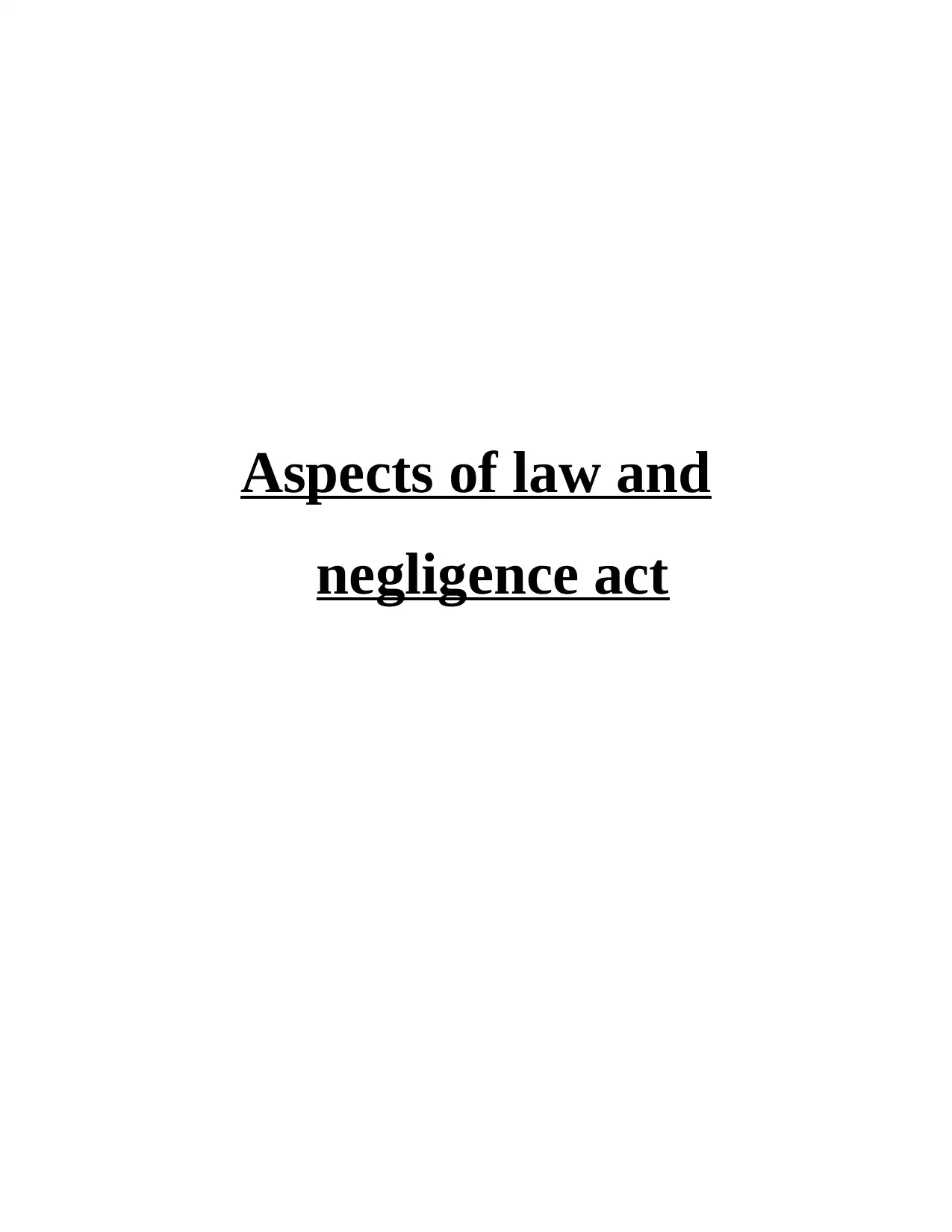
Aspects of law and
negligence act
negligence act
Paraphrase This Document
Need a fresh take? Get an instant paraphrase of this document with our AI Paraphraser
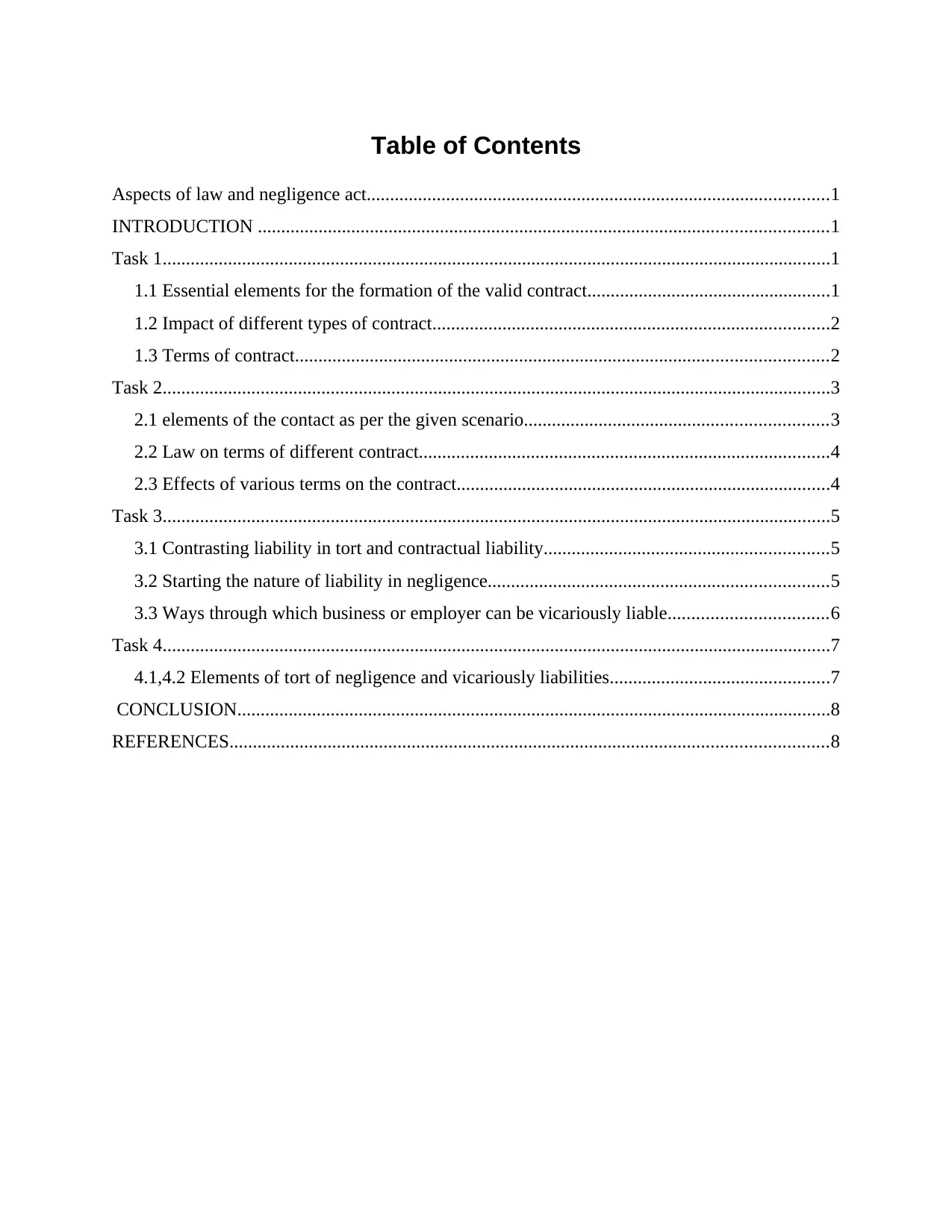
Table of Contents
Aspects of law and negligence act...................................................................................................1
INTRODUCTION ..........................................................................................................................1
Task 1...............................................................................................................................................1
1.1 Essential elements for the formation of the valid contract....................................................1
1.2 Impact of different types of contract.....................................................................................2
1.3 Terms of contract..................................................................................................................2
Task 2...............................................................................................................................................3
2.1 elements of the contact as per the given scenario.................................................................3
2.2 Law on terms of different contract........................................................................................4
2.3 Effects of various terms on the contract................................................................................4
Task 3...............................................................................................................................................5
3.1 Contrasting liability in tort and contractual liability.............................................................5
3.2 Starting the nature of liability in negligence.........................................................................5
3.3 Ways through which business or employer can be vicariously liable..................................6
Task 4...............................................................................................................................................7
4.1,4.2 Elements of tort of negligence and vicariously liabilities...............................................7
CONCLUSION...............................................................................................................................8
REFERENCES................................................................................................................................8
Aspects of law and negligence act...................................................................................................1
INTRODUCTION ..........................................................................................................................1
Task 1...............................................................................................................................................1
1.1 Essential elements for the formation of the valid contract....................................................1
1.2 Impact of different types of contract.....................................................................................2
1.3 Terms of contract..................................................................................................................2
Task 2...............................................................................................................................................3
2.1 elements of the contact as per the given scenario.................................................................3
2.2 Law on terms of different contract........................................................................................4
2.3 Effects of various terms on the contract................................................................................4
Task 3...............................................................................................................................................5
3.1 Contrasting liability in tort and contractual liability.............................................................5
3.2 Starting the nature of liability in negligence.........................................................................5
3.3 Ways through which business or employer can be vicariously liable..................................6
Task 4...............................................................................................................................................7
4.1,4.2 Elements of tort of negligence and vicariously liabilities...............................................7
CONCLUSION...............................................................................................................................8
REFERENCES................................................................................................................................8
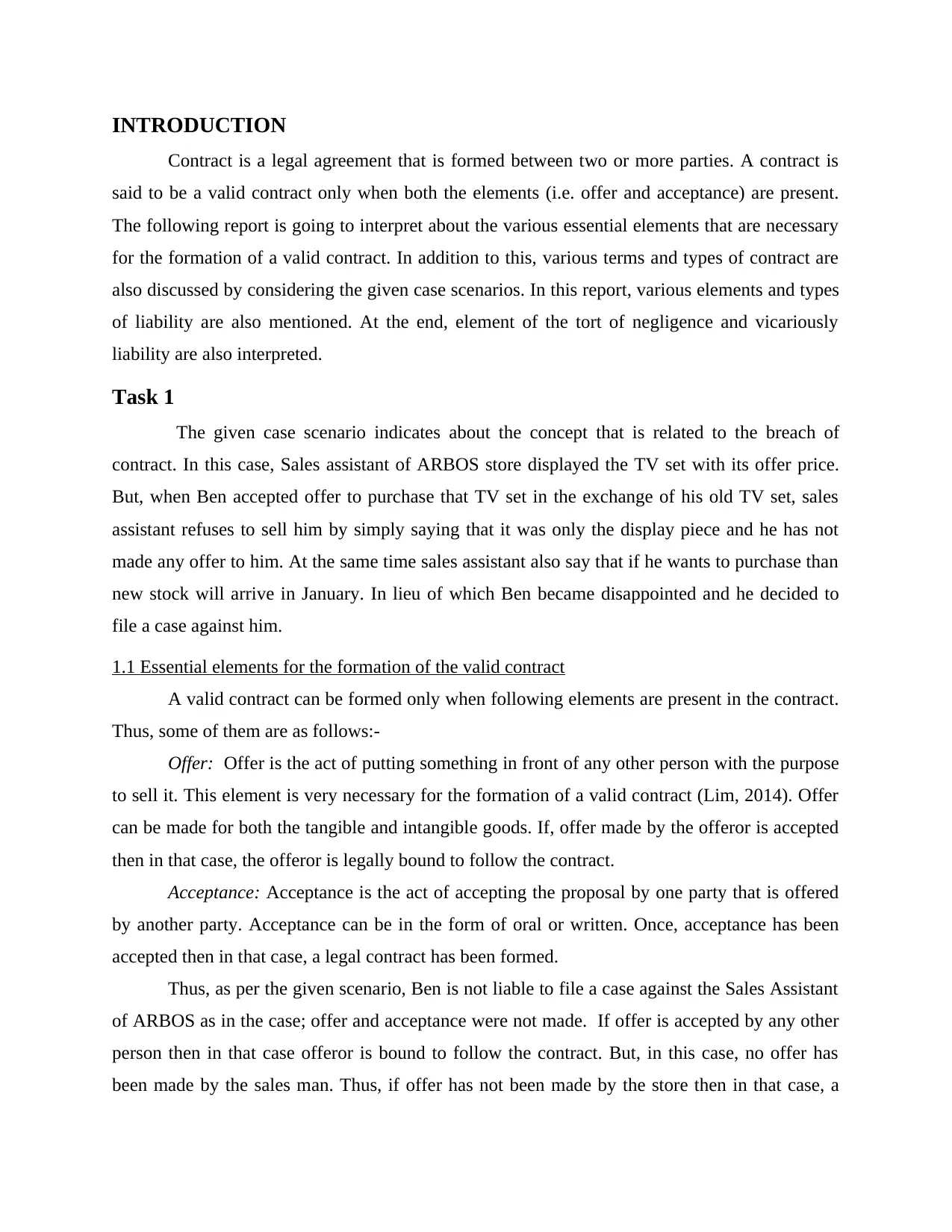
INTRODUCTION
Contract is a legal agreement that is formed between two or more parties. A contract is
said to be a valid contract only when both the elements (i.e. offer and acceptance) are present.
The following report is going to interpret about the various essential elements that are necessary
for the formation of a valid contract. In addition to this, various terms and types of contract are
also discussed by considering the given case scenarios. In this report, various elements and types
of liability are also mentioned. At the end, element of the tort of negligence and vicariously
liability are also interpreted.
Task 1
The given case scenario indicates about the concept that is related to the breach of
contract. In this case, Sales assistant of ARBOS store displayed the TV set with its offer price.
But, when Ben accepted offer to purchase that TV set in the exchange of his old TV set, sales
assistant refuses to sell him by simply saying that it was only the display piece and he has not
made any offer to him. At the same time sales assistant also say that if he wants to purchase than
new stock will arrive in January. In lieu of which Ben became disappointed and he decided to
file a case against him.
1.1 Essential elements for the formation of the valid contract
A valid contract can be formed only when following elements are present in the contract.
Thus, some of them are as follows:-
Offer: Offer is the act of putting something in front of any other person with the purpose
to sell it. This element is very necessary for the formation of a valid contract (Lim, 2014). Offer
can be made for both the tangible and intangible goods. If, offer made by the offeror is accepted
then in that case, the offeror is legally bound to follow the contract.
Acceptance: Acceptance is the act of accepting the proposal by one party that is offered
by another party. Acceptance can be in the form of oral or written. Once, acceptance has been
accepted then in that case, a legal contract has been formed.
Thus, as per the given scenario, Ben is not liable to file a case against the Sales Assistant
of ARBOS as in the case; offer and acceptance were not made. If offer is accepted by any other
person then in that case offeror is bound to follow the contract. But, in this case, no offer has
been made by the sales man. Thus, if offer has not been made by the store then in that case, a
Contract is a legal agreement that is formed between two or more parties. A contract is
said to be a valid contract only when both the elements (i.e. offer and acceptance) are present.
The following report is going to interpret about the various essential elements that are necessary
for the formation of a valid contract. In addition to this, various terms and types of contract are
also discussed by considering the given case scenarios. In this report, various elements and types
of liability are also mentioned. At the end, element of the tort of negligence and vicariously
liability are also interpreted.
Task 1
The given case scenario indicates about the concept that is related to the breach of
contract. In this case, Sales assistant of ARBOS store displayed the TV set with its offer price.
But, when Ben accepted offer to purchase that TV set in the exchange of his old TV set, sales
assistant refuses to sell him by simply saying that it was only the display piece and he has not
made any offer to him. At the same time sales assistant also say that if he wants to purchase than
new stock will arrive in January. In lieu of which Ben became disappointed and he decided to
file a case against him.
1.1 Essential elements for the formation of the valid contract
A valid contract can be formed only when following elements are present in the contract.
Thus, some of them are as follows:-
Offer: Offer is the act of putting something in front of any other person with the purpose
to sell it. This element is very necessary for the formation of a valid contract (Lim, 2014). Offer
can be made for both the tangible and intangible goods. If, offer made by the offeror is accepted
then in that case, the offeror is legally bound to follow the contract.
Acceptance: Acceptance is the act of accepting the proposal by one party that is offered
by another party. Acceptance can be in the form of oral or written. Once, acceptance has been
accepted then in that case, a legal contract has been formed.
Thus, as per the given scenario, Ben is not liable to file a case against the Sales Assistant
of ARBOS as in the case; offer and acceptance were not made. If offer is accepted by any other
person then in that case offeror is bound to follow the contract. But, in this case, no offer has
been made by the sales man. Thus, if offer has not been made by the store then in that case, a
⊘ This is a preview!⊘
Do you want full access?
Subscribe today to unlock all pages.

Trusted by 1+ million students worldwide
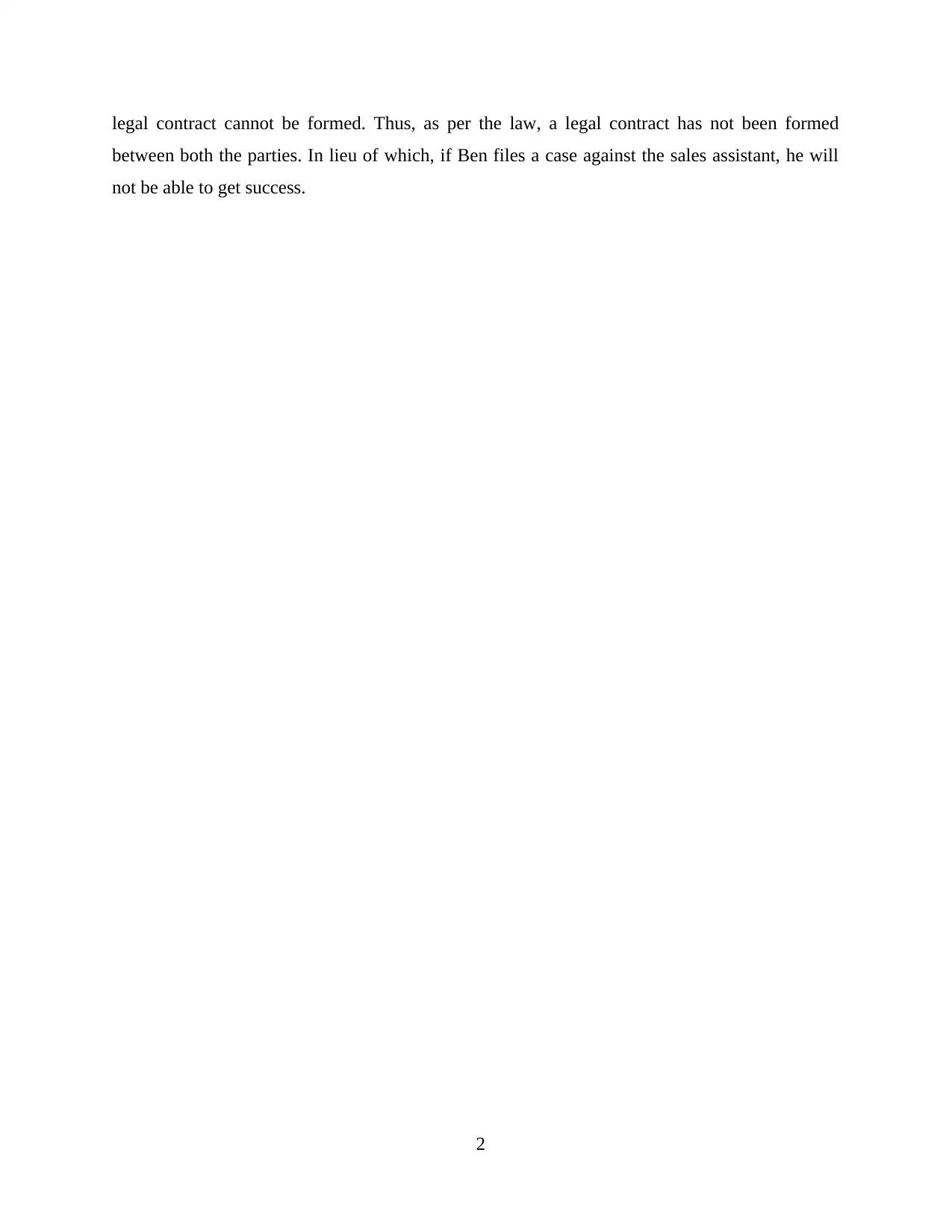
legal contract cannot be formed. Thus, as per the law, a legal contract has not been formed
between both the parties. In lieu of which, if Ben files a case against the sales assistant, he will
not be able to get success.
2
between both the parties. In lieu of which, if Ben files a case against the sales assistant, he will
not be able to get success.
2
Paraphrase This Document
Need a fresh take? Get an instant paraphrase of this document with our AI Paraphraser
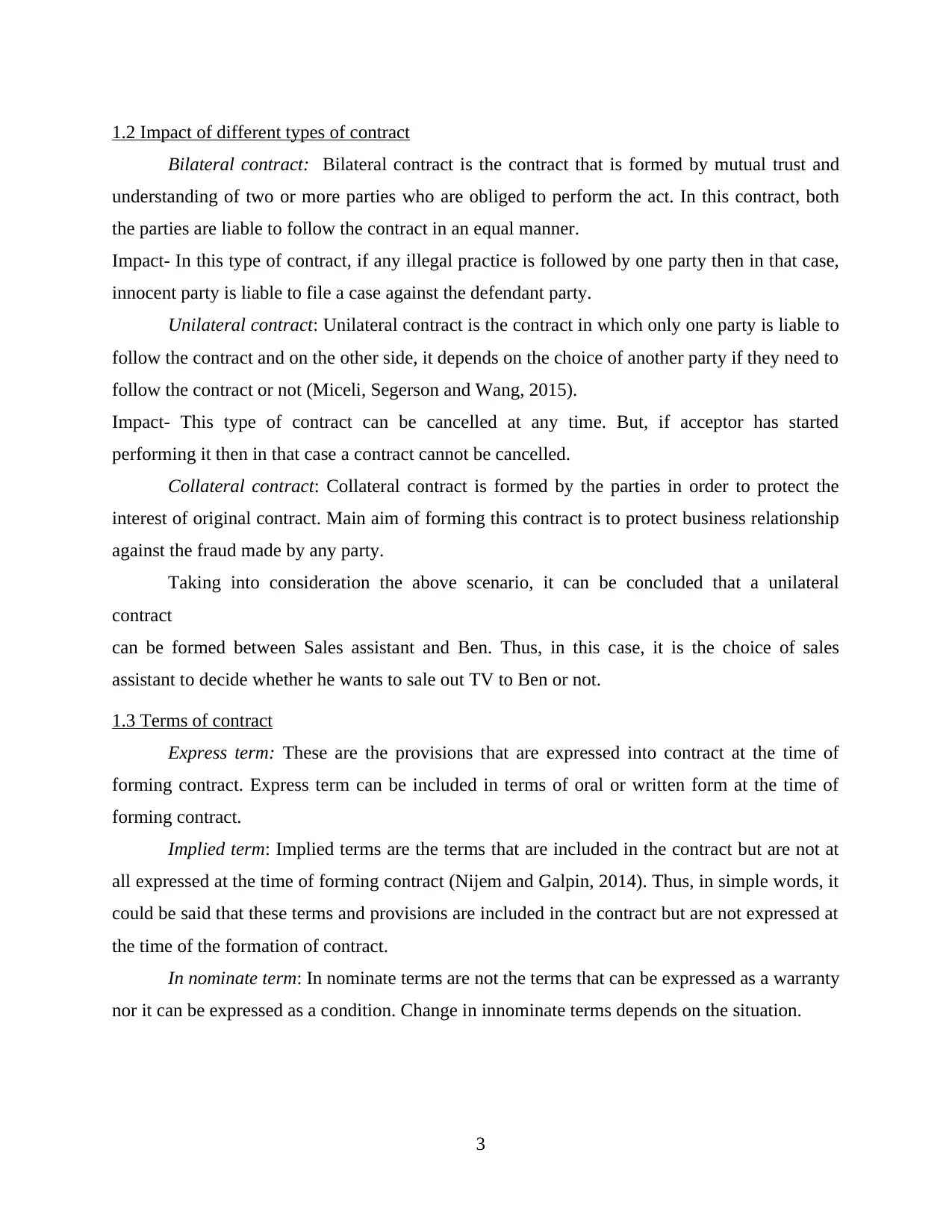
1.2 Impact of different types of contract
Bilateral contract: Bilateral contract is the contract that is formed by mutual trust and
understanding of two or more parties who are obliged to perform the act. In this contract, both
the parties are liable to follow the contract in an equal manner.
Impact- In this type of contract, if any illegal practice is followed by one party then in that case,
innocent party is liable to file a case against the defendant party.
Unilateral contract: Unilateral contract is the contract in which only one party is liable to
follow the contract and on the other side, it depends on the choice of another party if they need to
follow the contract or not (Miceli, Segerson and Wang, 2015).
Impact- This type of contract can be cancelled at any time. But, if acceptor has started
performing it then in that case a contract cannot be cancelled.
Collateral contract: Collateral contract is formed by the parties in order to protect the
interest of original contract. Main aim of forming this contract is to protect business relationship
against the fraud made by any party.
Taking into consideration the above scenario, it can be concluded that a unilateral
contract
can be formed between Sales assistant and Ben. Thus, in this case, it is the choice of sales
assistant to decide whether he wants to sale out TV to Ben or not.
1.3 Terms of contract
Express term: These are the provisions that are expressed into contract at the time of
forming contract. Express term can be included in terms of oral or written form at the time of
forming contract.
Implied term: Implied terms are the terms that are included in the contract but are not at
all expressed at the time of forming contract (Nijem and Galpin, 2014). Thus, in simple words, it
could be said that these terms and provisions are included in the contract but are not expressed at
the time of the formation of contract.
In nominate term: In nominate terms are not the terms that can be expressed as a warranty
nor it can be expressed as a condition. Change in innominate terms depends on the situation.
3
Bilateral contract: Bilateral contract is the contract that is formed by mutual trust and
understanding of two or more parties who are obliged to perform the act. In this contract, both
the parties are liable to follow the contract in an equal manner.
Impact- In this type of contract, if any illegal practice is followed by one party then in that case,
innocent party is liable to file a case against the defendant party.
Unilateral contract: Unilateral contract is the contract in which only one party is liable to
follow the contract and on the other side, it depends on the choice of another party if they need to
follow the contract or not (Miceli, Segerson and Wang, 2015).
Impact- This type of contract can be cancelled at any time. But, if acceptor has started
performing it then in that case a contract cannot be cancelled.
Collateral contract: Collateral contract is formed by the parties in order to protect the
interest of original contract. Main aim of forming this contract is to protect business relationship
against the fraud made by any party.
Taking into consideration the above scenario, it can be concluded that a unilateral
contract
can be formed between Sales assistant and Ben. Thus, in this case, it is the choice of sales
assistant to decide whether he wants to sale out TV to Ben or not.
1.3 Terms of contract
Express term: These are the provisions that are expressed into contract at the time of
forming contract. Express term can be included in terms of oral or written form at the time of
forming contract.
Implied term: Implied terms are the terms that are included in the contract but are not at
all expressed at the time of forming contract (Nijem and Galpin, 2014). Thus, in simple words, it
could be said that these terms and provisions are included in the contract but are not expressed at
the time of the formation of contract.
In nominate term: In nominate terms are not the terms that can be expressed as a warranty
nor it can be expressed as a condition. Change in innominate terms depends on the situation.
3
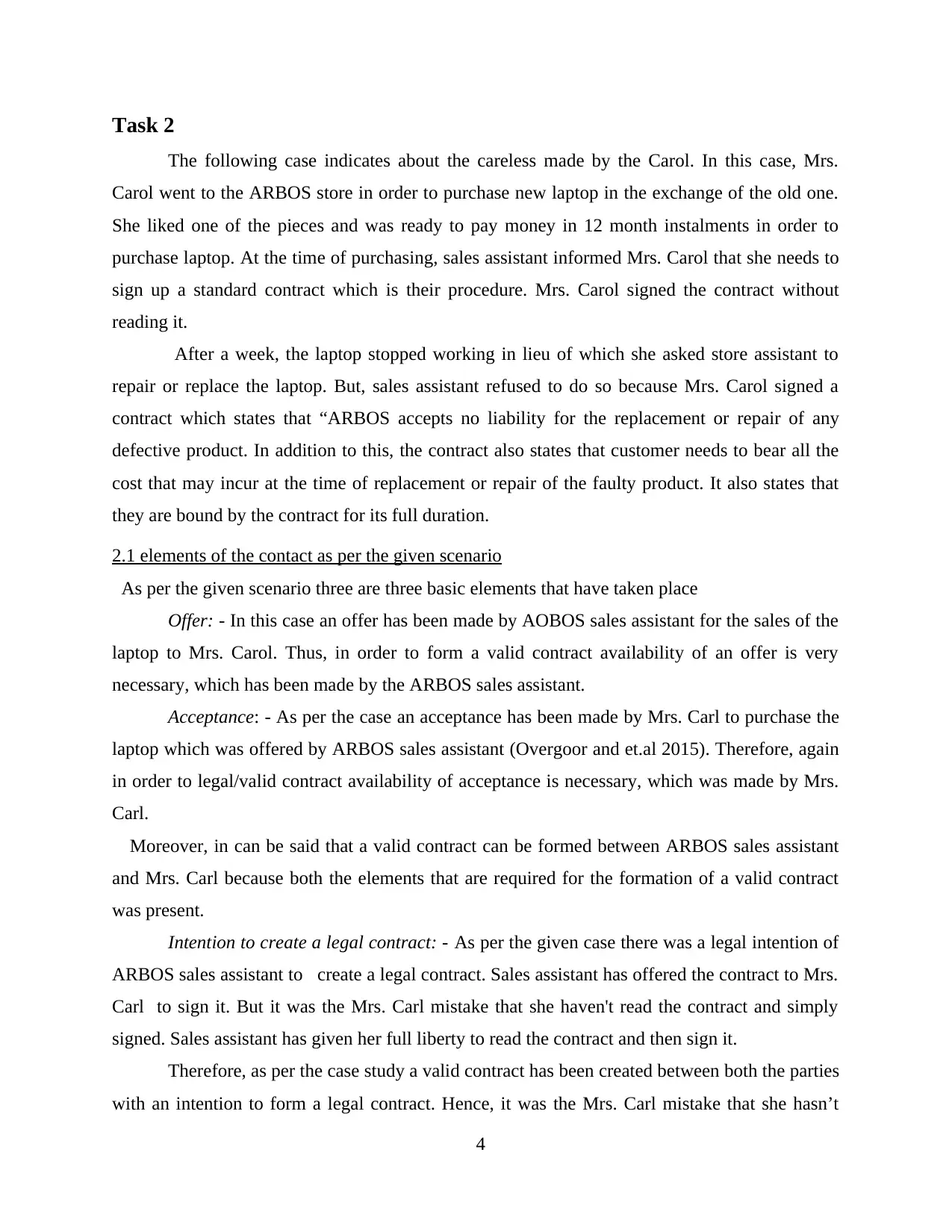
Task 2
The following case indicates about the careless made by the Carol. In this case, Mrs.
Carol went to the ARBOS store in order to purchase new laptop in the exchange of the old one.
She liked one of the pieces and was ready to pay money in 12 month instalments in order to
purchase laptop. At the time of purchasing, sales assistant informed Mrs. Carol that she needs to
sign up a standard contract which is their procedure. Mrs. Carol signed the contract without
reading it.
After a week, the laptop stopped working in lieu of which she asked store assistant to
repair or replace the laptop. But, sales assistant refused to do so because Mrs. Carol signed a
contract which states that “ARBOS accepts no liability for the replacement or repair of any
defective product. In addition to this, the contract also states that customer needs to bear all the
cost that may incur at the time of replacement or repair of the faulty product. It also states that
they are bound by the contract for its full duration.
2.1 elements of the contact as per the given scenario
As per the given scenario three are three basic elements that have taken place
Offer: - In this case an offer has been made by AOBOS sales assistant for the sales of the
laptop to Mrs. Carol. Thus, in order to form a valid contract availability of an offer is very
necessary, which has been made by the ARBOS sales assistant.
Acceptance: - As per the case an acceptance has been made by Mrs. Carl to purchase the
laptop which was offered by ARBOS sales assistant (Overgoor and et.al 2015). Therefore, again
in order to legal/valid contract availability of acceptance is necessary, which was made by Mrs.
Carl.
Moreover, in can be said that a valid contract can be formed between ARBOS sales assistant
and Mrs. Carl because both the elements that are required for the formation of a valid contract
was present.
Intention to create a legal contract: - As per the given case there was a legal intention of
ARBOS sales assistant to create a legal contract. Sales assistant has offered the contract to Mrs.
Carl to sign it. But it was the Mrs. Carl mistake that she haven't read the contract and simply
signed. Sales assistant has given her full liberty to read the contract and then sign it.
Therefore, as per the case study a valid contract has been created between both the parties
with an intention to form a legal contract. Hence, it was the Mrs. Carl mistake that she hasn’t
4
The following case indicates about the careless made by the Carol. In this case, Mrs.
Carol went to the ARBOS store in order to purchase new laptop in the exchange of the old one.
She liked one of the pieces and was ready to pay money in 12 month instalments in order to
purchase laptop. At the time of purchasing, sales assistant informed Mrs. Carol that she needs to
sign up a standard contract which is their procedure. Mrs. Carol signed the contract without
reading it.
After a week, the laptop stopped working in lieu of which she asked store assistant to
repair or replace the laptop. But, sales assistant refused to do so because Mrs. Carol signed a
contract which states that “ARBOS accepts no liability for the replacement or repair of any
defective product. In addition to this, the contract also states that customer needs to bear all the
cost that may incur at the time of replacement or repair of the faulty product. It also states that
they are bound by the contract for its full duration.
2.1 elements of the contact as per the given scenario
As per the given scenario three are three basic elements that have taken place
Offer: - In this case an offer has been made by AOBOS sales assistant for the sales of the
laptop to Mrs. Carol. Thus, in order to form a valid contract availability of an offer is very
necessary, which has been made by the ARBOS sales assistant.
Acceptance: - As per the case an acceptance has been made by Mrs. Carl to purchase the
laptop which was offered by ARBOS sales assistant (Overgoor and et.al 2015). Therefore, again
in order to legal/valid contract availability of acceptance is necessary, which was made by Mrs.
Carl.
Moreover, in can be said that a valid contract can be formed between ARBOS sales assistant
and Mrs. Carl because both the elements that are required for the formation of a valid contract
was present.
Intention to create a legal contract: - As per the given case there was a legal intention of
ARBOS sales assistant to create a legal contract. Sales assistant has offered the contract to Mrs.
Carl to sign it. But it was the Mrs. Carl mistake that she haven't read the contract and simply
signed. Sales assistant has given her full liberty to read the contract and then sign it.
Therefore, as per the case study a valid contract has been created between both the parties
with an intention to form a legal contract. Hence, it was the Mrs. Carl mistake that she hasn’t
4
⊘ This is a preview!⊘
Do you want full access?
Subscribe today to unlock all pages.

Trusted by 1+ million students worldwide
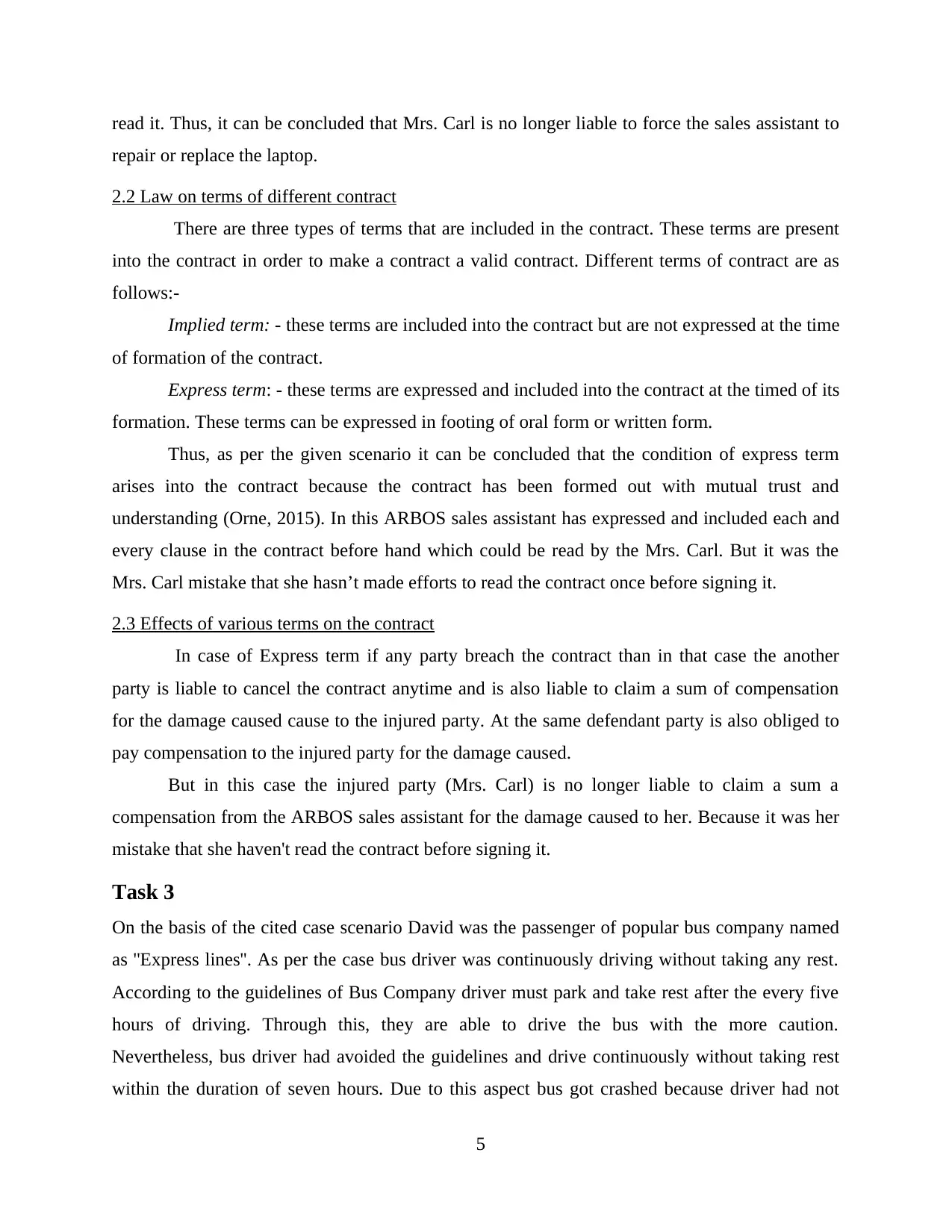
read it. Thus, it can be concluded that Mrs. Carl is no longer liable to force the sales assistant to
repair or replace the laptop.
2.2 Law on terms of different contract
There are three types of terms that are included in the contract. These terms are present
into the contract in order to make a contract a valid contract. Different terms of contract are as
follows:-
Implied term: - these terms are included into the contract but are not expressed at the time
of formation of the contract.
Express term: - these terms are expressed and included into the contract at the timed of its
formation. These terms can be expressed in footing of oral form or written form.
Thus, as per the given scenario it can be concluded that the condition of express term
arises into the contract because the contract has been formed out with mutual trust and
understanding (Orne, 2015). In this ARBOS sales assistant has expressed and included each and
every clause in the contract before hand which could be read by the Mrs. Carl. But it was the
Mrs. Carl mistake that she hasn’t made efforts to read the contract once before signing it.
2.3 Effects of various terms on the contract
In case of Express term if any party breach the contract than in that case the another
party is liable to cancel the contract anytime and is also liable to claim a sum of compensation
for the damage caused cause to the injured party. At the same defendant party is also obliged to
pay compensation to the injured party for the damage caused.
But in this case the injured party (Mrs. Carl) is no longer liable to claim a sum a
compensation from the ARBOS sales assistant for the damage caused to her. Because it was her
mistake that she haven't read the contract before signing it.
Task 3
On the basis of the cited case scenario David was the passenger of popular bus company named
as ''Express lines''. As per the case bus driver was continuously driving without taking any rest.
According to the guidelines of Bus Company driver must park and take rest after the every five
hours of driving. Through this, they are able to drive the bus with the more caution.
Nevertheless, bus driver had avoided the guidelines and drive continuously without taking rest
within the duration of seven hours. Due to this aspect bus got crashed because driver had not
5
repair or replace the laptop.
2.2 Law on terms of different contract
There are three types of terms that are included in the contract. These terms are present
into the contract in order to make a contract a valid contract. Different terms of contract are as
follows:-
Implied term: - these terms are included into the contract but are not expressed at the time
of formation of the contract.
Express term: - these terms are expressed and included into the contract at the timed of its
formation. These terms can be expressed in footing of oral form or written form.
Thus, as per the given scenario it can be concluded that the condition of express term
arises into the contract because the contract has been formed out with mutual trust and
understanding (Orne, 2015). In this ARBOS sales assistant has expressed and included each and
every clause in the contract before hand which could be read by the Mrs. Carl. But it was the
Mrs. Carl mistake that she hasn’t made efforts to read the contract once before signing it.
2.3 Effects of various terms on the contract
In case of Express term if any party breach the contract than in that case the another
party is liable to cancel the contract anytime and is also liable to claim a sum of compensation
for the damage caused cause to the injured party. At the same defendant party is also obliged to
pay compensation to the injured party for the damage caused.
But in this case the injured party (Mrs. Carl) is no longer liable to claim a sum a
compensation from the ARBOS sales assistant for the damage caused to her. Because it was her
mistake that she haven't read the contract before signing it.
Task 3
On the basis of the cited case scenario David was the passenger of popular bus company named
as ''Express lines''. As per the case bus driver was continuously driving without taking any rest.
According to the guidelines of Bus Company driver must park and take rest after the every five
hours of driving. Through this, they are able to drive the bus with the more caution.
Nevertheless, bus driver had avoided the guidelines and drive continuously without taking rest
within the duration of seven hours. Due to this aspect bus got crashed because driver had not
5
Paraphrase This Document
Need a fresh take? Get an instant paraphrase of this document with our AI Paraphraser
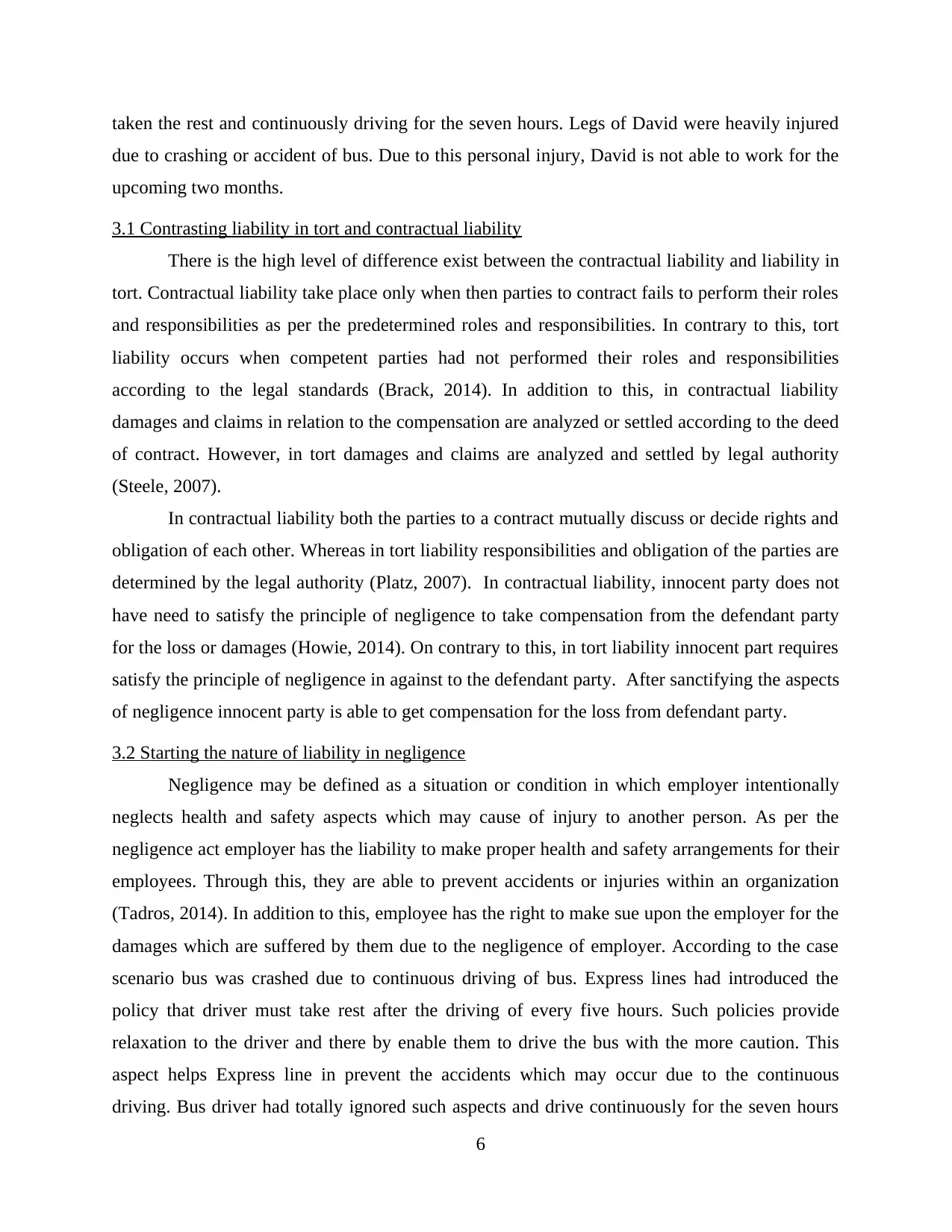
taken the rest and continuously driving for the seven hours. Legs of David were heavily injured
due to crashing or accident of bus. Due to this personal injury, David is not able to work for the
upcoming two months.
3.1 Contrasting liability in tort and contractual liability
There is the high level of difference exist between the contractual liability and liability in
tort. Contractual liability take place only when then parties to contract fails to perform their roles
and responsibilities as per the predetermined roles and responsibilities. In contrary to this, tort
liability occurs when competent parties had not performed their roles and responsibilities
according to the legal standards (Brack, 2014). In addition to this, in contractual liability
damages and claims in relation to the compensation are analyzed or settled according to the deed
of contract. However, in tort damages and claims are analyzed and settled by legal authority
(Steele, 2007).
In contractual liability both the parties to a contract mutually discuss or decide rights and
obligation of each other. Whereas in tort liability responsibilities and obligation of the parties are
determined by the legal authority (Platz, 2007). In contractual liability, innocent party does not
have need to satisfy the principle of negligence to take compensation from the defendant party
for the loss or damages (Howie, 2014). On contrary to this, in tort liability innocent part requires
satisfy the principle of negligence in against to the defendant party. After sanctifying the aspects
of negligence innocent party is able to get compensation for the loss from defendant party.
3.2 Starting the nature of liability in negligence
Negligence may be defined as a situation or condition in which employer intentionally
neglects health and safety aspects which may cause of injury to another person. As per the
negligence act employer has the liability to make proper health and safety arrangements for their
employees. Through this, they are able to prevent accidents or injuries within an organization
(Tadros, 2014). In addition to this, employee has the right to make sue upon the employer for the
damages which are suffered by them due to the negligence of employer. According to the case
scenario bus was crashed due to continuous driving of bus. Express lines had introduced the
policy that driver must take rest after the driving of every five hours. Such policies provide
relaxation to the driver and there by enable them to drive the bus with the more caution. This
aspect helps Express line in prevent the accidents which may occur due to the continuous
driving. Bus driver had totally ignored such aspects and drive continuously for the seven hours
6
due to crashing or accident of bus. Due to this personal injury, David is not able to work for the
upcoming two months.
3.1 Contrasting liability in tort and contractual liability
There is the high level of difference exist between the contractual liability and liability in
tort. Contractual liability take place only when then parties to contract fails to perform their roles
and responsibilities as per the predetermined roles and responsibilities. In contrary to this, tort
liability occurs when competent parties had not performed their roles and responsibilities
according to the legal standards (Brack, 2014). In addition to this, in contractual liability
damages and claims in relation to the compensation are analyzed or settled according to the deed
of contract. However, in tort damages and claims are analyzed and settled by legal authority
(Steele, 2007).
In contractual liability both the parties to a contract mutually discuss or decide rights and
obligation of each other. Whereas in tort liability responsibilities and obligation of the parties are
determined by the legal authority (Platz, 2007). In contractual liability, innocent party does not
have need to satisfy the principle of negligence to take compensation from the defendant party
for the loss or damages (Howie, 2014). On contrary to this, in tort liability innocent part requires
satisfy the principle of negligence in against to the defendant party. After sanctifying the aspects
of negligence innocent party is able to get compensation for the loss from defendant party.
3.2 Starting the nature of liability in negligence
Negligence may be defined as a situation or condition in which employer intentionally
neglects health and safety aspects which may cause of injury to another person. As per the
negligence act employer has the liability to make proper health and safety arrangements for their
employees. Through this, they are able to prevent accidents or injuries within an organization
(Tadros, 2014). In addition to this, employee has the right to make sue upon the employer for the
damages which are suffered by them due to the negligence of employer. According to the case
scenario bus was crashed due to continuous driving of bus. Express lines had introduced the
policy that driver must take rest after the driving of every five hours. Such policies provide
relaxation to the driver and there by enable them to drive the bus with the more caution. This
aspect helps Express line in prevent the accidents which may occur due to the continuous
driving. Bus driver had totally ignored such aspects and drive continuously for the seven hours
6
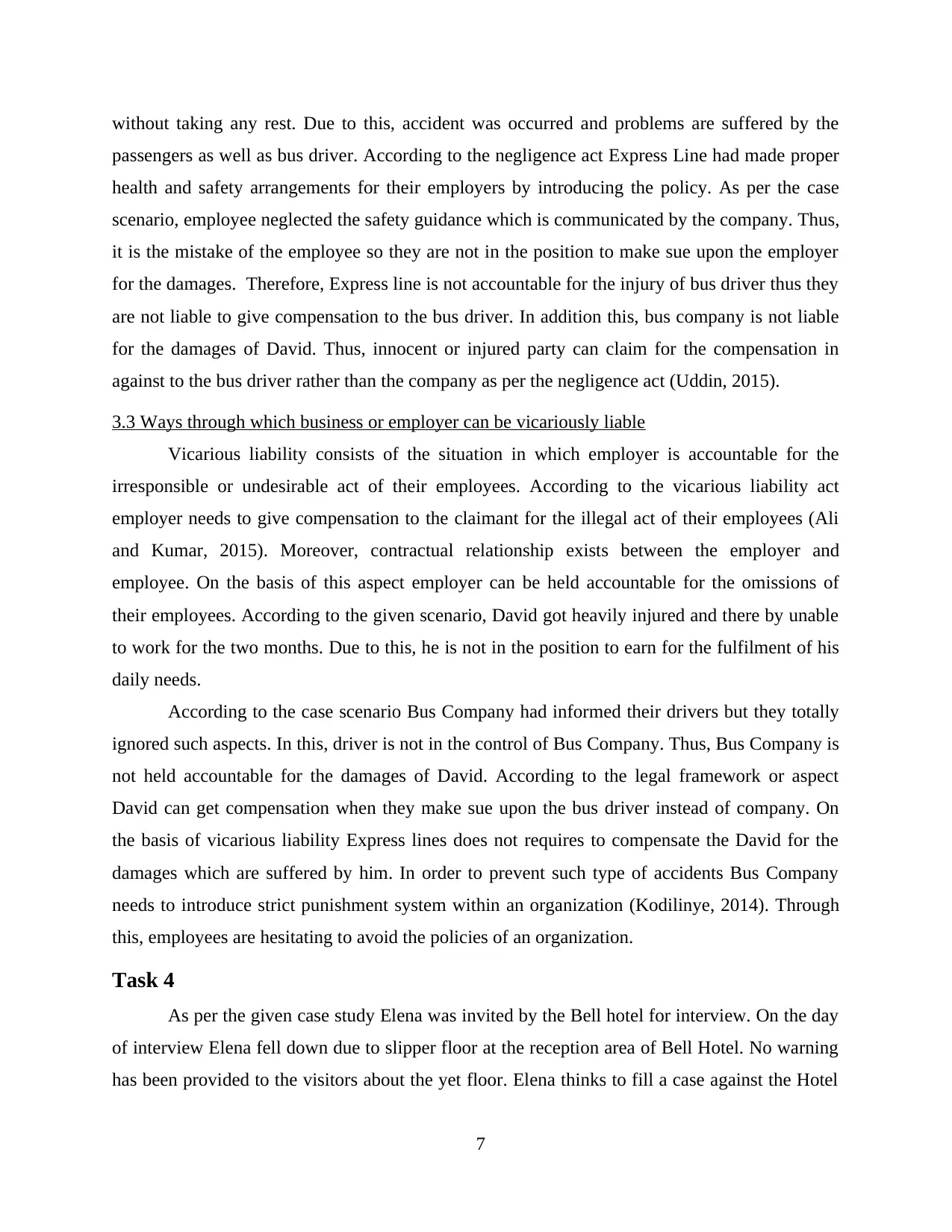
without taking any rest. Due to this, accident was occurred and problems are suffered by the
passengers as well as bus driver. According to the negligence act Express Line had made proper
health and safety arrangements for their employers by introducing the policy. As per the case
scenario, employee neglected the safety guidance which is communicated by the company. Thus,
it is the mistake of the employee so they are not in the position to make sue upon the employer
for the damages. Therefore, Express line is not accountable for the injury of bus driver thus they
are not liable to give compensation to the bus driver. In addition this, bus company is not liable
for the damages of David. Thus, innocent or injured party can claim for the compensation in
against to the bus driver rather than the company as per the negligence act (Uddin, 2015).
3.3 Ways through which business or employer can be vicariously liable
Vicarious liability consists of the situation in which employer is accountable for the
irresponsible or undesirable act of their employees. According to the vicarious liability act
employer needs to give compensation to the claimant for the illegal act of their employees (Ali
and Kumar, 2015). Moreover, contractual relationship exists between the employer and
employee. On the basis of this aspect employer can be held accountable for the omissions of
their employees. According to the given scenario, David got heavily injured and there by unable
to work for the two months. Due to this, he is not in the position to earn for the fulfilment of his
daily needs.
According to the case scenario Bus Company had informed their drivers but they totally
ignored such aspects. In this, driver is not in the control of Bus Company. Thus, Bus Company is
not held accountable for the damages of David. According to the legal framework or aspect
David can get compensation when they make sue upon the bus driver instead of company. On
the basis of vicarious liability Express lines does not requires to compensate the David for the
damages which are suffered by him. In order to prevent such type of accidents Bus Company
needs to introduce strict punishment system within an organization (Kodilinye, 2014). Through
this, employees are hesitating to avoid the policies of an organization.
Task 4
As per the given case study Elena was invited by the Bell hotel for interview. On the day
of interview Elena fell down due to slipper floor at the reception area of Bell Hotel. No warning
has been provided to the visitors about the yet floor. Elena thinks to fill a case against the Hotel
7
passengers as well as bus driver. According to the negligence act Express Line had made proper
health and safety arrangements for their employers by introducing the policy. As per the case
scenario, employee neglected the safety guidance which is communicated by the company. Thus,
it is the mistake of the employee so they are not in the position to make sue upon the employer
for the damages. Therefore, Express line is not accountable for the injury of bus driver thus they
are not liable to give compensation to the bus driver. In addition this, bus company is not liable
for the damages of David. Thus, innocent or injured party can claim for the compensation in
against to the bus driver rather than the company as per the negligence act (Uddin, 2015).
3.3 Ways through which business or employer can be vicariously liable
Vicarious liability consists of the situation in which employer is accountable for the
irresponsible or undesirable act of their employees. According to the vicarious liability act
employer needs to give compensation to the claimant for the illegal act of their employees (Ali
and Kumar, 2015). Moreover, contractual relationship exists between the employer and
employee. On the basis of this aspect employer can be held accountable for the omissions of
their employees. According to the given scenario, David got heavily injured and there by unable
to work for the two months. Due to this, he is not in the position to earn for the fulfilment of his
daily needs.
According to the case scenario Bus Company had informed their drivers but they totally
ignored such aspects. In this, driver is not in the control of Bus Company. Thus, Bus Company is
not held accountable for the damages of David. According to the legal framework or aspect
David can get compensation when they make sue upon the bus driver instead of company. On
the basis of vicarious liability Express lines does not requires to compensate the David for the
damages which are suffered by him. In order to prevent such type of accidents Bus Company
needs to introduce strict punishment system within an organization (Kodilinye, 2014). Through
this, employees are hesitating to avoid the policies of an organization.
Task 4
As per the given case study Elena was invited by the Bell hotel for interview. On the day
of interview Elena fell down due to slipper floor at the reception area of Bell Hotel. No warning
has been provided to the visitors about the yet floor. Elena thinks to fill a case against the Hotel
7
⊘ This is a preview!⊘
Do you want full access?
Subscribe today to unlock all pages.

Trusted by 1+ million students worldwide
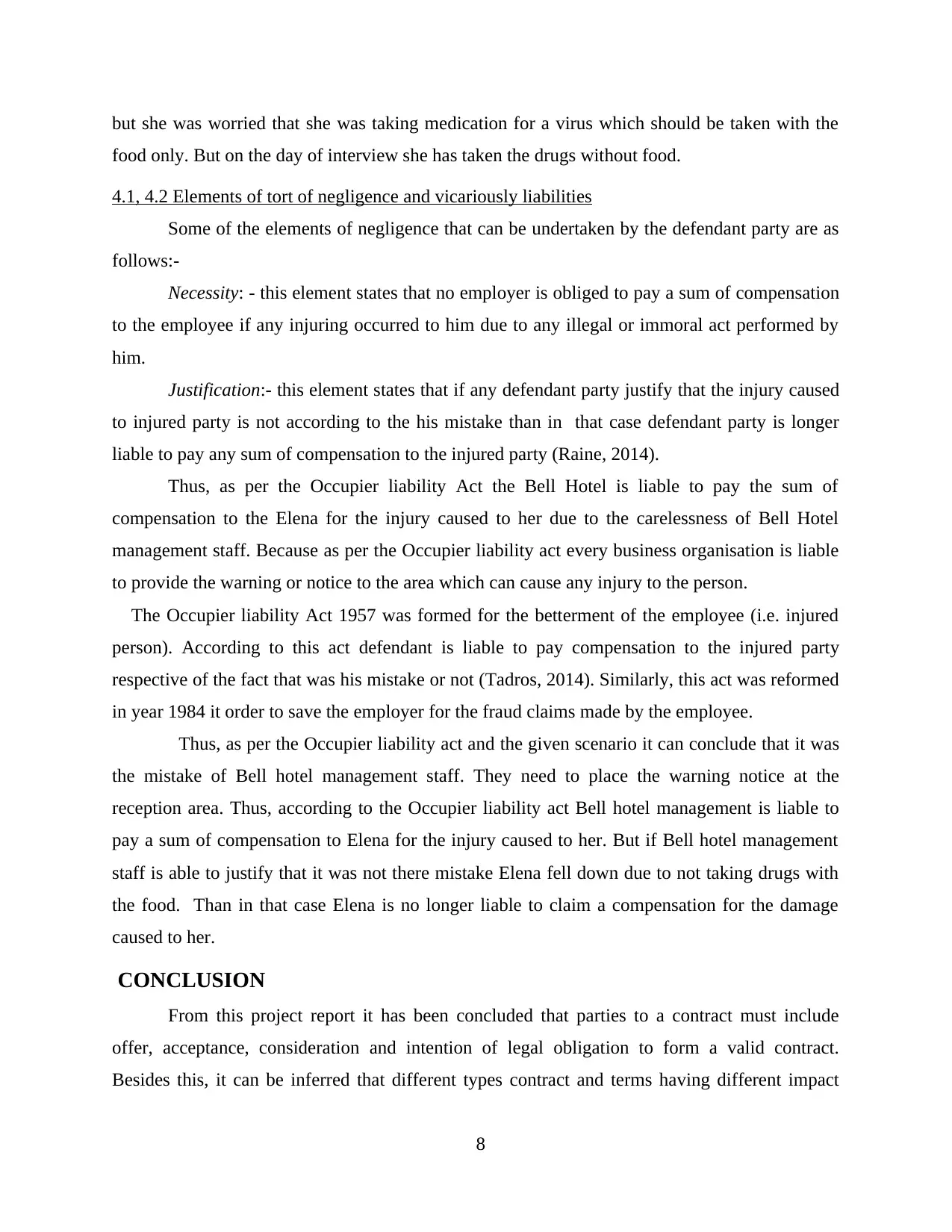
but she was worried that she was taking medication for a virus which should be taken with the
food only. But on the day of interview she has taken the drugs without food.
4.1, 4.2 Elements of tort of negligence and vicariously liabilities
Some of the elements of negligence that can be undertaken by the defendant party are as
follows:-
Necessity: - this element states that no employer is obliged to pay a sum of compensation
to the employee if any injuring occurred to him due to any illegal or immoral act performed by
him.
Justification:- this element states that if any defendant party justify that the injury caused
to injured party is not according to the his mistake than in that case defendant party is longer
liable to pay any sum of compensation to the injured party (Raine, 2014).
Thus, as per the Occupier liability Act the Bell Hotel is liable to pay the sum of
compensation to the Elena for the injury caused to her due to the carelessness of Bell Hotel
management staff. Because as per the Occupier liability act every business organisation is liable
to provide the warning or notice to the area which can cause any injury to the person.
The Occupier liability Act 1957 was formed for the betterment of the employee (i.e. injured
person). According to this act defendant is liable to pay compensation to the injured party
respective of the fact that was his mistake or not (Tadros, 2014). Similarly, this act was reformed
in year 1984 it order to save the employer for the fraud claims made by the employee.
Thus, as per the Occupier liability act and the given scenario it can conclude that it was
the mistake of Bell hotel management staff. They need to place the warning notice at the
reception area. Thus, according to the Occupier liability act Bell hotel management is liable to
pay a sum of compensation to Elena for the injury caused to her. But if Bell hotel management
staff is able to justify that it was not there mistake Elena fell down due to not taking drugs with
the food. Than in that case Elena is no longer liable to claim a compensation for the damage
caused to her.
CONCLUSION
From this project report it has been concluded that parties to a contract must include
offer, acceptance, consideration and intention of legal obligation to form a valid contract.
Besides this, it can be inferred that different types contract and terms having different impact
8
food only. But on the day of interview she has taken the drugs without food.
4.1, 4.2 Elements of tort of negligence and vicariously liabilities
Some of the elements of negligence that can be undertaken by the defendant party are as
follows:-
Necessity: - this element states that no employer is obliged to pay a sum of compensation
to the employee if any injuring occurred to him due to any illegal or immoral act performed by
him.
Justification:- this element states that if any defendant party justify that the injury caused
to injured party is not according to the his mistake than in that case defendant party is longer
liable to pay any sum of compensation to the injured party (Raine, 2014).
Thus, as per the Occupier liability Act the Bell Hotel is liable to pay the sum of
compensation to the Elena for the injury caused to her due to the carelessness of Bell Hotel
management staff. Because as per the Occupier liability act every business organisation is liable
to provide the warning or notice to the area which can cause any injury to the person.
The Occupier liability Act 1957 was formed for the betterment of the employee (i.e. injured
person). According to this act defendant is liable to pay compensation to the injured party
respective of the fact that was his mistake or not (Tadros, 2014). Similarly, this act was reformed
in year 1984 it order to save the employer for the fraud claims made by the employee.
Thus, as per the Occupier liability act and the given scenario it can conclude that it was
the mistake of Bell hotel management staff. They need to place the warning notice at the
reception area. Thus, according to the Occupier liability act Bell hotel management is liable to
pay a sum of compensation to Elena for the injury caused to her. But if Bell hotel management
staff is able to justify that it was not there mistake Elena fell down due to not taking drugs with
the food. Than in that case Elena is no longer liable to claim a compensation for the damage
caused to her.
CONCLUSION
From this project report it has been concluded that parties to a contract must include
offer, acceptance, consideration and intention of legal obligation to form a valid contract.
Besides this, it can be inferred that different types contract and terms having different impact
8
Paraphrase This Document
Need a fresh take? Get an instant paraphrase of this document with our AI Paraphraser
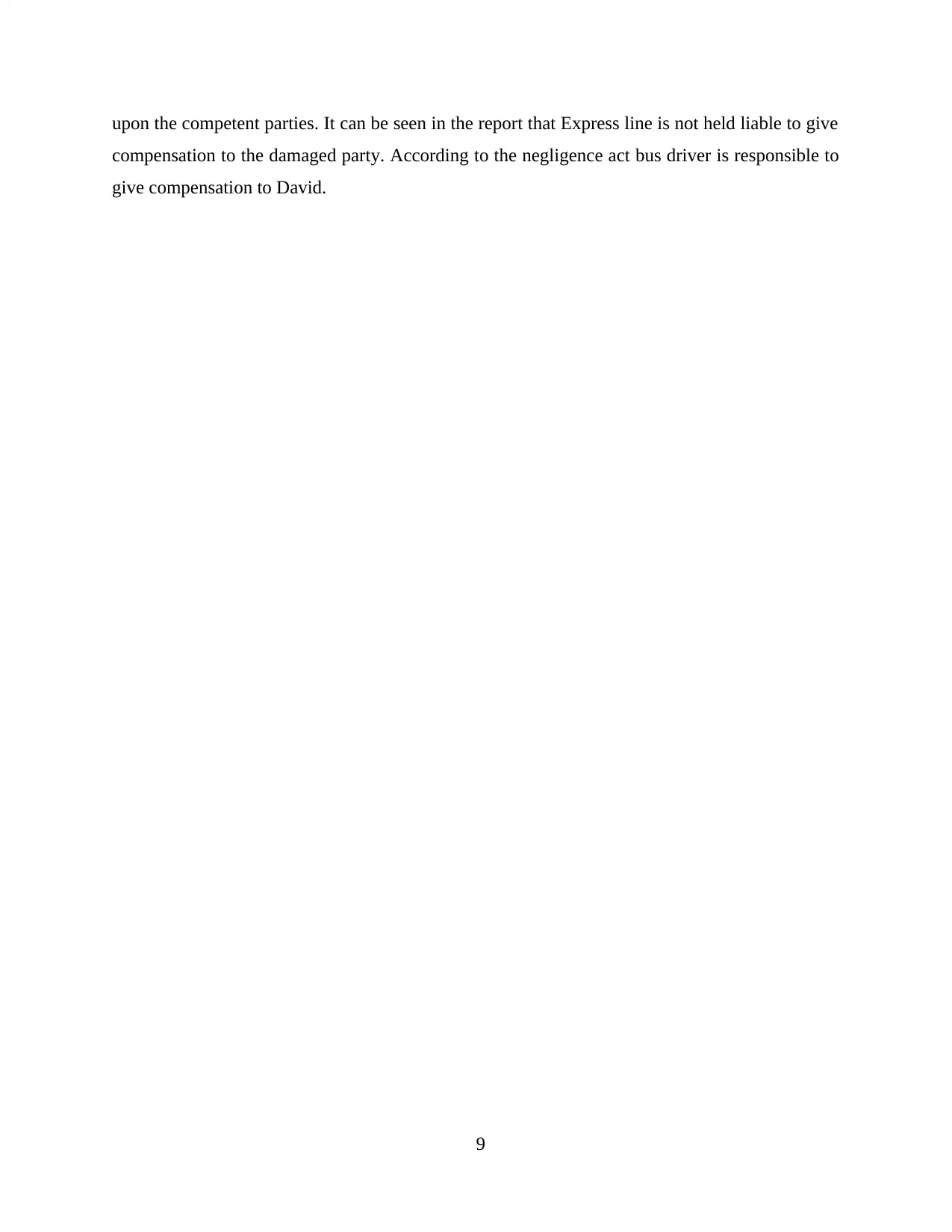
upon the competent parties. It can be seen in the report that Express line is not held liable to give
compensation to the damaged party. According to the negligence act bus driver is responsible to
give compensation to David.
9
compensation to the damaged party. According to the negligence act bus driver is responsible to
give compensation to David.
9
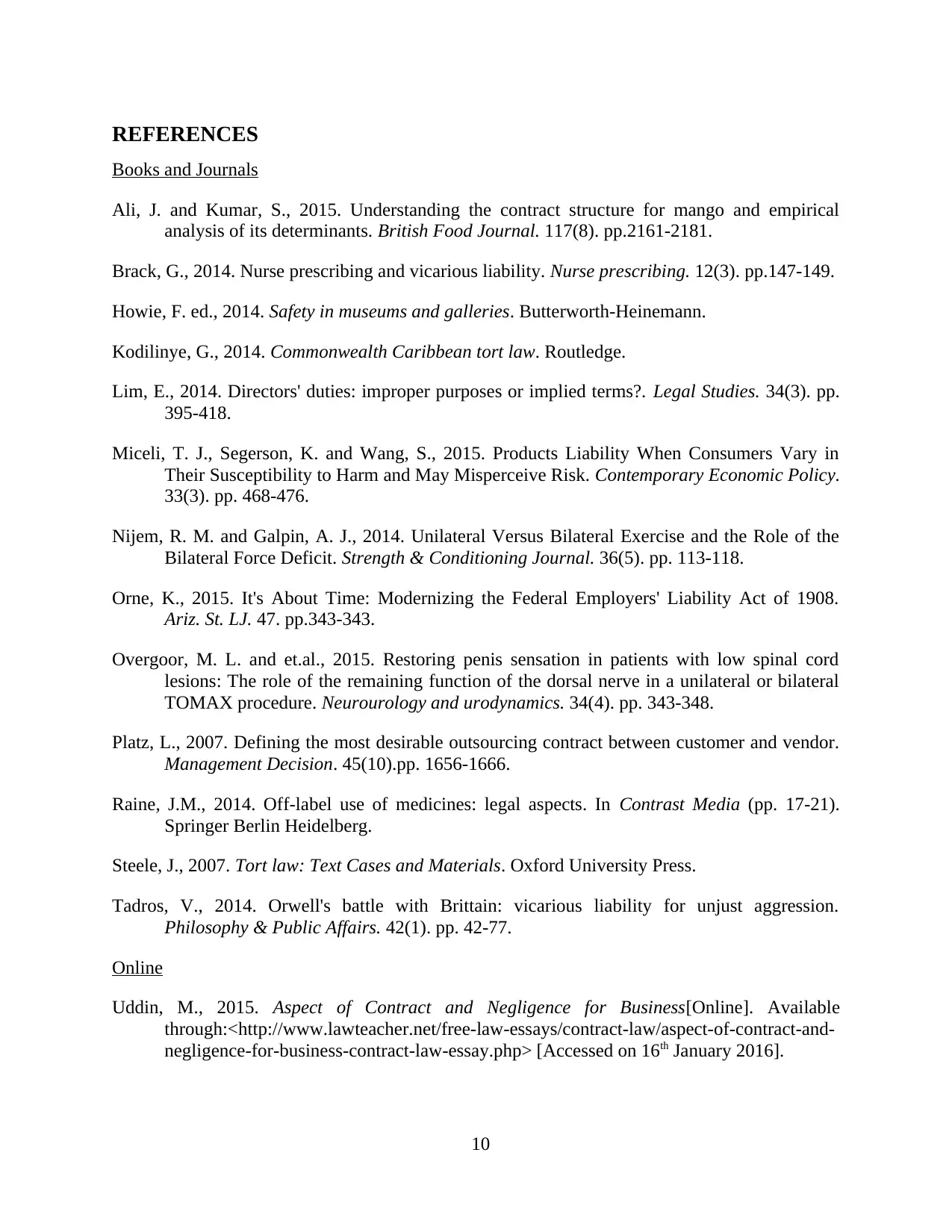
REFERENCES
Books and Journals
Ali, J. and Kumar, S., 2015. Understanding the contract structure for mango and empirical
analysis of its determinants. British Food Journal. 117(8). pp.2161-2181.
Brack, G., 2014. Nurse prescribing and vicarious liability. Nurse prescribing. 12(3). pp.147-149.
Howie, F. ed., 2014. Safety in museums and galleries. Butterworth-Heinemann.
Kodilinye, G., 2014. Commonwealth Caribbean tort law. Routledge.
Lim, E., 2014. Directors' duties: improper purposes or implied terms?. Legal Studies. 34(3). pp.
395-418.
Miceli, T. J., Segerson, K. and Wang, S., 2015. Products Liability When Consumers Vary in
Their Susceptibility to Harm and May Misperceive Risk. Contemporary Economic Policy.
33(3). pp. 468-476.
Nijem, R. M. and Galpin, A. J., 2014. Unilateral Versus Bilateral Exercise and the Role of the
Bilateral Force Deficit. Strength & Conditioning Journal. 36(5). pp. 113-118.
Orne, K., 2015. It's About Time: Modernizing the Federal Employers' Liability Act of 1908.
Ariz. St. LJ. 47. pp.343-343.
Overgoor, M. L. and et.al., 2015. Restoring penis sensation in patients with low spinal cord
lesions: The role of the remaining function of the dorsal nerve in a unilateral or bilateral
TOMAX procedure. Neurourology and urodynamics. 34(4). pp. 343-348.
Platz, L., 2007. Defining the most desirable outsourcing contract between customer and vendor.
Management Decision. 45(10).pp. 1656-1666.
Raine, J.M., 2014. Off-label use of medicines: legal aspects. In Contrast Media (pp. 17-21).
Springer Berlin Heidelberg.
Steele, J., 2007. Tort law: Text Cases and Materials. Oxford University Press.
Tadros, V., 2014. Orwell's battle with Brittain: vicarious liability for unjust aggression.
Philosophy & Public Affairs. 42(1). pp. 42-77.
Online
Uddin, M., 2015. Aspect of Contract and Negligence for Business[Online]. Available
through:<http://www.lawteacher.net/free-law-essays/contract-law/aspect-of-contract-and-
negligence-for-business-contract-law-essay.php> [Accessed on 16th January 2016].
10
Books and Journals
Ali, J. and Kumar, S., 2015. Understanding the contract structure for mango and empirical
analysis of its determinants. British Food Journal. 117(8). pp.2161-2181.
Brack, G., 2014. Nurse prescribing and vicarious liability. Nurse prescribing. 12(3). pp.147-149.
Howie, F. ed., 2014. Safety in museums and galleries. Butterworth-Heinemann.
Kodilinye, G., 2014. Commonwealth Caribbean tort law. Routledge.
Lim, E., 2014. Directors' duties: improper purposes or implied terms?. Legal Studies. 34(3). pp.
395-418.
Miceli, T. J., Segerson, K. and Wang, S., 2015. Products Liability When Consumers Vary in
Their Susceptibility to Harm and May Misperceive Risk. Contemporary Economic Policy.
33(3). pp. 468-476.
Nijem, R. M. and Galpin, A. J., 2014. Unilateral Versus Bilateral Exercise and the Role of the
Bilateral Force Deficit. Strength & Conditioning Journal. 36(5). pp. 113-118.
Orne, K., 2015. It's About Time: Modernizing the Federal Employers' Liability Act of 1908.
Ariz. St. LJ. 47. pp.343-343.
Overgoor, M. L. and et.al., 2015. Restoring penis sensation in patients with low spinal cord
lesions: The role of the remaining function of the dorsal nerve in a unilateral or bilateral
TOMAX procedure. Neurourology and urodynamics. 34(4). pp. 343-348.
Platz, L., 2007. Defining the most desirable outsourcing contract between customer and vendor.
Management Decision. 45(10).pp. 1656-1666.
Raine, J.M., 2014. Off-label use of medicines: legal aspects. In Contrast Media (pp. 17-21).
Springer Berlin Heidelberg.
Steele, J., 2007. Tort law: Text Cases and Materials. Oxford University Press.
Tadros, V., 2014. Orwell's battle with Brittain: vicarious liability for unjust aggression.
Philosophy & Public Affairs. 42(1). pp. 42-77.
Online
Uddin, M., 2015. Aspect of Contract and Negligence for Business[Online]. Available
through:<http://www.lawteacher.net/free-law-essays/contract-law/aspect-of-contract-and-
negligence-for-business-contract-law-essay.php> [Accessed on 16th January 2016].
10
⊘ This is a preview!⊘
Do you want full access?
Subscribe today to unlock all pages.

Trusted by 1+ million students worldwide
1 out of 12
Related Documents
Your All-in-One AI-Powered Toolkit for Academic Success.
+13062052269
info@desklib.com
Available 24*7 on WhatsApp / Email
![[object Object]](/_next/static/media/star-bottom.7253800d.svg)
Unlock your academic potential
Copyright © 2020–2025 A2Z Services. All Rights Reserved. Developed and managed by ZUCOL.





